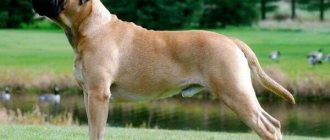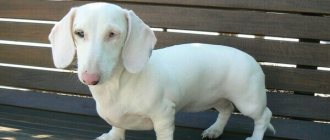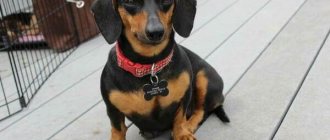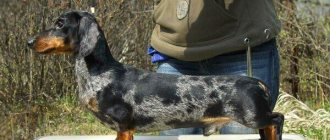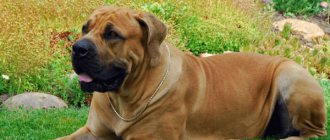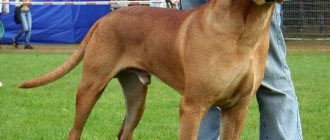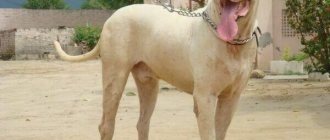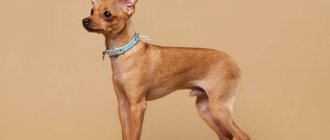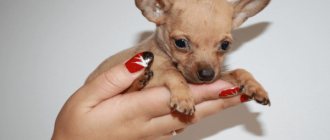The Dachshund has an original appearance, which allows it to be one of the most easily recognizable dog breeds.
Dachshunds were originally bred for burrow hunting.
A small dog with a long body, short strong legs, brave, energetic and intelligent, it was an indispensable assistant in the hunt for rabbits, badgers and even foxes.
Today, dachshunds are not only used for their intended purpose, but also kept as pets.
The fashion for decorative dogs has not gone away for two centuries.
Origin story
Miniature dachshunds, just like standard ones, were created for the needs of hunting a specific animal.
Hunters needed a dog that could easily penetrate the small holes of rabbits that infested southern Germany. Work on breeding a greatly reduced dachshund began at the end of the 19th century in Germany under the leadership of Dr. Engelmann .
The first attempts were unsuccessful. Breeders took the path of crossing standard dachshunds and representatives of smaller breeds, most often miniature pinschers.
But as a result, the dogs either lost the hunting qualities inherent in dachshunds, or became nervous little dogs with straight, thin, high legs and a narrow chest.
It was necessary to carry out selection work exclusively within the breed, selecting its smallest representatives with pronounced hunting habits. Success came in the 90s of the 19th century, and in 1905 a club for rabbit dachshund lovers was organized.
In addition to the standard dachshund, German dog handlers have developed two varieties of it:
- dwarf,
- rabbit
Today in our country they are also breeding miniature dachshunds. All producers of the breed were exported from abroad. According to documents, some of them have “working” or hunting origins.
Popular nurseries
- Golden Daxhund, Moscow region, Odintsovo
- From Omsk Fortress, Omsk
- Caladium Vis-a-vis, Moscow
- Caroline Yudzhel, Moscow
- Kinchville, Moscow
- Fox Nose, St. Petersburg
- Minidogland, Smolensk
- Myshkin House, Moscow
- Magic Rainbow, St. Petersburg
- Norden Licht, Moscow
- Rus Bramers, Moscow
- From the Marvelous Mountains, Krasnoyarsk Territory, Divnogorsk
- Stayer's, Tula
- Formula for success, Moscow
- Certus, St. Petersburg
You can easily find the websites of these nurseries on the Internet, as well as the coordinates of their owners.
Description of the breed
The miniature or dwarf dachshund is a small dog with an elongated body on short, strong legs . Three times less than the standard fee.
Very active and cheerful.
Nowadays it is more often used not for its intended purpose, as a hunter, but as a lap dog. A good companion and friend.
Needs training.
Attitude towards children
A dachshund and a child are an ideal couple . Representatives of this breed treat children very carefully, often perceiving them as their own. If there is a lack of parental attention, the dachshund, to the best of its canine strength, can compensate the baby for the lack of communication.
These dogs are capable of tirelessly playing and frolicking with the baby, but even in the midst of fun they are restrained and are unlikely to bite the child.
If the baby greatly tires the animal, it will simply leave for a while and will soon return again to continue active communication.
It is best if the dachshund appeared in the house after the birth of the child, since representatives of the breed can often show the “newcomer” their leadership in the house, although they will love them equally with other family members.
Pet character
The character of the dog was formed over a long time based on the specific needs of burrow hunting.
Hunting activity has developed in dachshunds the ability to make decisions independently, think logically, be able to wait for the moment, and act quickly and decisively . The dachshund is a smart, cunning, balanced dog.
The behavior of a dog directly depends on its origin, on how long the “working”, hunting stage was in its family. A close hunting heritage gives the dog self-confidence, fearlessness, and a passion for exploration.
IMPORTANT!
Much in a dog’s character depends on upbringing and training.
Dachshunds are very loyal, but they also require a lot of attention. At a young age, pets are very playful and inquisitive, they definitely need to try everything on their teeth, so they cannot do without special dog toys, otherwise everything that the little explorer can get to will be used as such.
In an adult dog, playfulness is replaced by excitement, in the heat of which it can chase the supposed “game” without listening to the owner’s commands.
Therefore, during a walk, if you are not completely sure that your pet is under control, it is better not to let him off the leash.
The dog is quite loud and can bark for a long time at the slightest noise. Alone - howl.
Dachshunds are very energetic and resilient. Daily walks with feasible physical activity are vital for them, and they will be extremely happy about long hikes in nature.
The breeding of hunting dogs in our country is increasingly dominated by the decorative direction . This also applies to dachshunds.
Therefore, the courage, determination, and bravery characteristic of daring hunters, finding no practical application, gradually disappears from the character of pets.
Standards and photo of what it looks like
The breed standards are the same for all three varieties of dachshunds - regular, dwarf and rabbit. The only differences are in size.
Dwarf and rabbit dachshunds also differ in size.
Dwarf - larger (despite the name):
- The head is small, elongated. The jaws are tightly closed. Full teeth are important
- Large triangular hanging ears with rounded edges are adjacent to the muzzle.
- The eyes are almond-shaped and dark in color. Eye color ranges from light amber to deep brown. For merle-colored dogs, blue is acceptable.
- The nose is black, in marbled varieties it is lightened.
- The body is elongated, the chest is protruding, the back is straight and strong, the muscles are well defined. The transition from chest to stomach is smooth.
- The tail is long and thin, set level with the back, or moves freely.
- The legs are short, wide and powerful, the forelimbs are slightly curved, the hind limbs are more widely set and more muscular.
- The skin is not saggy, tightly fitting
- The coat is short and smooth.
Expert opinion
Kozhevin Semyon Kirillovich
Expert dog handler.
Dachshunds are very smart and cunning dogs. They tend to make their own decisions, so getting commands to be followed can be difficult. I almost never train my dogs; these smartest creatures understand me perfectly. Sometimes I achieve obedience simply by using the right intonation. Do not leave the dog unattended, talk to it. Dachshunds are highly intelligent; they can easily understand what their owner wants from them. When walking, especially in nature, do not forget about the hunting instinct of the dachshund; in pursuit of prey, the dog may forget that it is decorative and run away without listening to commands.
Intelligence. Reviews
The dog has a stable nervous system. It is quite difficult to anger an animal. It is no coincidence that dogs of this breed get along well with small children and cats. The decorative dachshund is especially popular. Reviews from owners show that the dog easily gets along with all family members and other pets.
All dachshunds are very disciplined and easy to train. The developed intelligence of a dog exceeds basic instincts. It's rare to find a dachshund that would chase a cat. But the dog always obeys commands unquestioningly.
Despite the fact that the dog is small in size, it has a well-developed guard instinct. A dachshund can perfectly guard a house. Reviews from lovers of this breed speak for themselves. The dog will not allow strangers into its territory. She will bark loudly and growl at the one who poses a potential threat to the owner.
What is the difference from the breed standard?
According to the breed standard, miniature dachshunds are not allowed:
- tallness,
- saggy lips,
- high-ass,
- lack of teeth,
- sagging or hunchbacked back,
- underdeveloped muscles,
- pointed ears,
- blue eyes (except marble ones),
- clumsy movements.
Basic colors
The breed standard allows colors:
- Single-colored (red, dark red, sand. Some degree of admixture of black wool is possible. The most highly valued colors are pure colors. The most valuable is fiery red).
- Two-color (dark brown or black with red, reddish tan). Small white markings on the chest are acceptable.
- Marble. The main color is dark (auburn, black, gray), the spots are of a lighter shade. The location of the spots is chaotic.
- Tigers . There are two types: dark red with even darker stripes and sand color with stripes. In merle and brindle colors, white color is very unwelcome, too extensive spots, rich black color.
Advantages and disadvantages
| pros | Minuses |
| cheerful character | stubbornness |
| high intelligence | rancor |
| endurance | disobedience |
| sociability | barking loudly for any reason |
| devotion | excessive independence |
| ease of care | cold intolerance |
| innate hunting and guarding abilities | hunting instinct, which can manifest itself in digging up the entire area |
Life expectancy, illness and health
On average, dachshunds live 10-12 years . With proper care and good health they can live up to 15-16 years.
Dachshunds have health problems that are specific to this breed.
Problem number one - diseases of the spine - the price to pay for an elongated functional body :
- Displacement of intervertebral discs. Affects adult dogs over five years of age. It manifests itself in the fact that the dog cannot find a comfortable position for a long time. Over time, the hind legs may fail.
- It is necessary to engage in prevention from childhood and strengthen the muscles of the spine. Swimming is perfect for these purposes. For a miniature dachshund with its size, a bath is enough. It’s good to let them carry sticks in their teeth. Climb the steps. If you need to go down the stairs to go for a walk, it is better to carry the dog in your arms. Jumping from heights is contraindicated.
- Swimmer's syndrome (osteoporosis of puppies). Affects babies one month old. Puppies do not stand on their paws, they move on their stomachs. The reason is a lack of essential minerals in the diet, excess weight. With timely, proper treatment, the disease recedes.
- Skin dystrophy (acanthosis nigricans). Manifests itself in increased pigmentation in the chest, abdomen, and armpits. The skin sags in thick folds, the hair falls out. The cause of the disease is not clear. It is believed that this is a genetic disease. Stress can trigger illness. Obesity may play a significant role. Treatment by a veterinarian.
- Dachshunds are not immune from ear mites, like all long-eared dogs.
- Smooth-haired dachshunds (large and small) often have abnormal eyelash growth (eyelashes arranged in two rows or at right angles). Fixed promptly.
Dachshund in the apartment. Host reviews
Reviews from people who have a dog in an apartment are very varied. Those who have a small home say that the breed is optimal for such an apartment. The dog is particularly careful. She will never tear up wallpaper or shit under the sofa.
The dachshund always wants to be close to its owner. Therefore, it does not matter whether she lives in a country house or in a city apartment. But the dachshund does not tolerate small spaces. When organizing a place for a pet, the owner must take into account that the dog likes to spend time actively. The exception is the dwarf dachshund. Reviews about this breed indicate that the dog feels great even in a small room.
Basic rules of care
Caring for a baby is not difficult.
It is enough to adhere to a simple rule: the creature, although small, is a real dog, it needs attention and care. If you take raising your dog seriously from the very beginning, you can avoid many problems in the future :
- Your pet needs toys that can be chewed.
- The animal’s energy should splash out on walks that are quite long and active.
- After a walk, be sure to examine your dog to ensure it doesn't pick up ticks.
- You can bathe 2-3 times a year.
- Smooth fur is cleaned by wiping with a suede cloth, or a bristle brush, or a terry towel.
- Wipe the eyes with a clean damp cloth.
- The ears are cleaned with a cotton swab soaked in hydrogen peroxide.
- Clean teeth can be achieved with the right food.
- A puppy's nails should be cut once every two weeks; an adult dog's nails should be trimmed once every three months. The first time this procedure is best done by a veterinarian.
- During the cold season, the dog needs special clothing.
What not to do:
- walk your pet before vaccination;
- allow you to jump from a height;
- lift by the scruff of the neck;
- stand on your hind legs.
Accessories
The Dachshund loves to surround itself with a variety of little things. If you do not purchase special toys for your pet, he will begin to entertain himself with surrounding objects. There should be quite a lot of rubber balls and bones. The only thing the owner should take care of is the proper organization of the sleeping area. The rabbit dachshund especially loves comfort. Feedback from owners makes it possible to understand that a dog develops correctly only if its space is properly organized.
There are special mattresses and houses for dachshunds on sale that can be placed both in a large home and in a small apartment. The dog should not sleep on toys. Healthy sleep for your pet is of great importance. The bed should not be very soft. A hard mattress will help avoid spinal problems in your dachshund.
How to feed
Dachshunds are prone to obesity, so the main rule is not to overfeed.
You can give preference to ready-made food (premium class) or natural food, but do not mix them.
frequency :
- up to four months - 5 times a day;
- from four to eight months - 3-4 times;
- adult dog - 2 times a day.
Recommended Products:
- Meat (except pork)
- Fish (once or twice a week)
- Cereals (millet, rice, buckwheat)
- Fermented milk products, cottage cheese, cheese
- Eggs (boiled yolk, white is not digestible)
- Any fruits and vegetables according to the dog’s taste preferences.
Sausages and smoked meats, salty and fatty foods are prohibited. Sweets.
Coat types
- Smooth-haired. The coat does not exceed 1 cm in length, smooth, close to the body, not rough. The undercoat is also short, soft, but not fluffy.
- Long-haired. On the body, limbs and ears, the hair is wavy, thick and quite long - from 5 to 10 cm. On the head it is short, smooth and close-fitting.
- Wirehaired. The coat is short - up to 3 cm, wiry, thick and dense. On the face it forms eyebrows, mustache and beard, typical for this variety.
Price range
The price range for a dachshund is very wide, ranging from 2,000 rubles to 60,000 thousand rubles.
Price depends on:
- presence of pedigree;
- puppy age;
- availability of a veterinary passport;
- specialization of the dog (working or decorative);
- merits of parents (titles, awards, work diplomas).
How to choose a puppy?
You need to decide on the purpose of the purchase. Will the dog be used as a working dog or as a decorative one, will it be exhibited or will it just be a companion, a member of the family?
You definitely need to listen to the advice of professional breeders, people who have experience in keeping such dogs..
NOTE!
It is very important to study the pedigree well and look at the puppy’s parents.
The puppy itself should not be fearful or shy, but cheerful, playful, with an excellent appetite.

